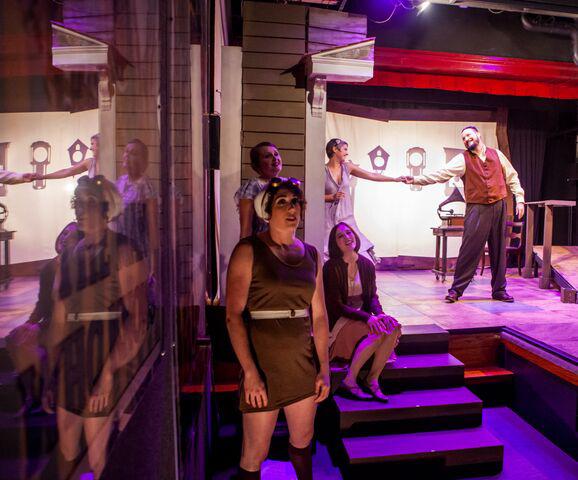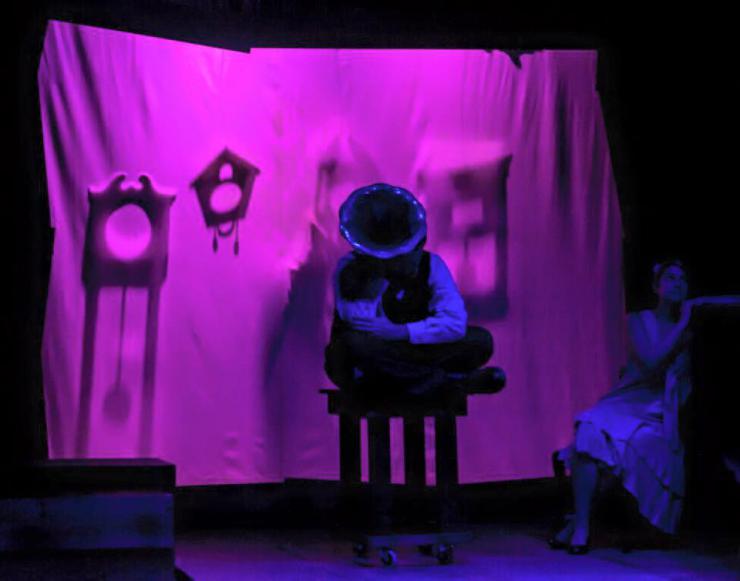Failure
Why Taking Risks is Still Essential
There is a trope in our culture that persists across every narrative medium, which suggests we must take great risks to achieve great results. Again and again, we see plucky heroes risk failure only to achieve greatness at the last possible moment. This trope teaches us that success is the payoff for risk. Yet, I think they’re missing the real point.
When I first read Phillip Dawkins play Failure: A Love Story, I knew two things. For starters, the play could be an absolute cluster-fuck if done improperly, and second, I desperately wanted to do the play. Dawkins script offers an almost unheard level of collaboration for a company producing the work. Great swathes of the play are assigned to a “chorus.” In a note in the script, Dawkins suggests many ways this can be handled, encouraging companies to find even more approaches. He states, “It is possible to tell this story with as few as four actors, or as many as fifty. So have fun.”
A troupe performing this play almost needs to become a group of devisers as they search for meaning, character, and focus on the script. In addition, inanimate objects are active characters, and animals have large scenes and speaking roles. There is a lot of room to play with this play, and a joke that was made countless times throughout our rehearsal process: there was a lot of room for “failure.”
Theatre [502] included Failure in their 2015-2016 season. To embrace the spirit of collaboration offered by the playwright, director Gil Reyes used the production team as performers. He cast his assistant director, one of his carpenters, and his light and sound designers. I was invited to participate as an actor, a dramaturg, and choreographer.

The process was tough. In public talkbacks, Reyes was open about the process, calling the show “a bear,” and the hardest show he’s ever done. It took its toll on the actors too, and there was a time when I truly didn’t think we’d make it, but I did my best to trust the process and my director.
Our production of Failure featured elaborate shadow puppets, played out on a ten by fifteen foot screen at the back of the stage. The shadows provided backdrop sets, and additional characters—parakeets, or sprits of dead loved ones. The shadow puppet screen also covered all the backstage business, including numerous large shadow puppets, a giant snake puppet, and at any time several actors waiting for their next entrance. Much of the music—it was also sort of a musical—was provided by our ingénue/sound designer/ukulele player; so sometimes she was back stage strumming away as well.
In the last week of rehearsal, really the last two days, the show came together. Even though we were still working problem transitions an hour before we opened, we all felt like we had done something important and brave. We had risked failure, and succeeded in producing Failure.
I was extra proud, having championed the play throughout the season scheduling process. But you know what they say about pride, right? In the penultimate scene, I was a gramophone with the aid of a gramophone horn and a wheeled table. At the end of the scene, I was supposed to jump down off the table, and move on to the next scene.

As the lights dimmed on that scene on opening night, I scooted my butt slightly back on the table, just like I always did, to put my feet on the ground and—“Oh Jesus the table is tipping,” I thought. Time slowed and I had several distinct thoughts, all based on trying to save the moment, and what to do in the next moment if that plan failed. “Can I stay on my feet?” No. “Can I stop the table from falling on top of me?” No. “How far back am I going to fall?” Far. “Oh God the screen, am I going to hit the screen? Yes. I’m hitting the screen, Jesus please don't let me go through—” I went through the screen and tore it down with me.
After a thousand of years of falling, I lay onstage in full view of the audience, destroying the illusions and magic that my colleagues and friends had pushed so hard to create. A sighed "fuck" escaped my lips.
Then, I got the hell up. Luckily, the screened hadn't torn, just collapsed. I ran backstage and I sort of secured the screen with a black clamp that was mercifully within arms reach. We did the rest of the show. I had only one moment backstage in the dark to hang my head and wish for escape from my torrent of emotions.
Shame. Embarrassment. Humiliation. In thirty plus years as a theatre artist, essentially my entire life as I can remember it, I have never fucked up that bad onstage. Never. One thought kept falling through my mind—"I will never act again. I will never let myself feel this defeated ever again.
As I processed my emotions opening night, I realized if I stop acting, I’m living in fear and making choices based on one moment of shame and embarrassment. That’s no life at all.
“I'll finish out the run, but then I'm done,” I thought while I finished opening night, bowing awkwardly with a snake puppet, my body beginning to blossom with pain as my adrenaline faded. I held myself together after the show as my friends and the director all worriedly checked on me to see if I was physically hurt. But when I got in the car to drive home, I cried the whole way.
Despite my tumble, Failure was a huge success by every metric we have for measurement—ticket sales, reviews, and audience reactions. But for me, that wasn’t the point. I got back on stage the next night, and the next night, and finished the run. I’ve already accepted parts for later in the year. I will not bow out. When I finish all the plays I’m working on, I’ll keep auditioning.
And maybe someday I’ll mess up again as badly as I did the opening night of Failure. But I’ll keep going. As I processed my emotions opening night, I realized if I stop acting, I’m living in fear and making choices based on one moment of shame and embarrassment. That’s no life at all.
There is a trope in our culture that persists across every narrative medium, which suggests we must take great risks to achieve great results. This trope teaches us that success is the payoff for risk. I think they’re missing the real point because the payoff for risk isn’t success; it’s having a life worth living.


Comments
The article is just the start of the conversation—we want to know what you think about this subject, too! HowlRound is a space for knowledge-sharing, and we welcome spirited, thoughtful, and on-topic dialogue. Find our full comments policy here